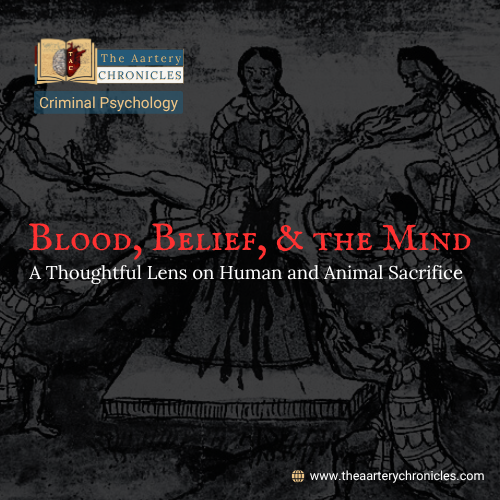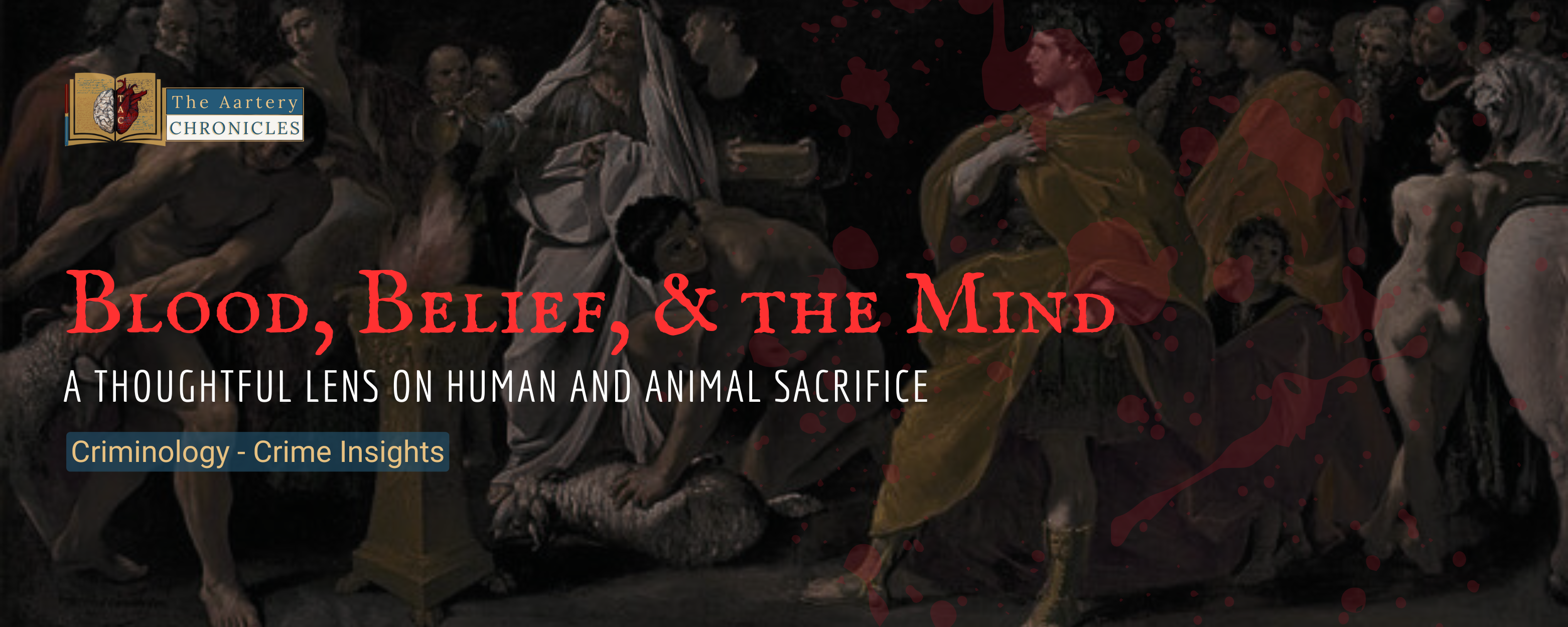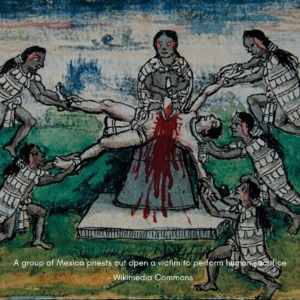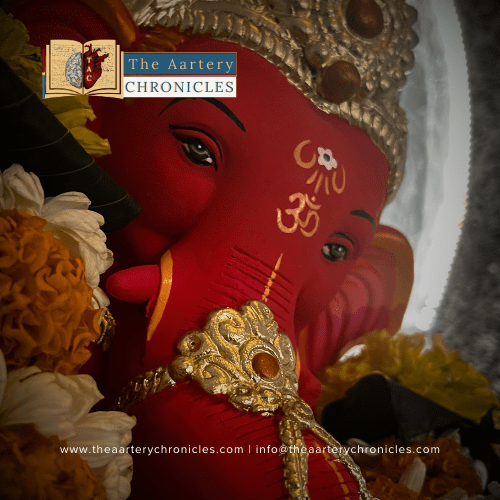

Blood, Belief, & the Mind: A Thoughtful Lens on Human and Animal Sacrifice
When the human mind tussles with desperation, greed, and the relentless pursuit of solutions, and these are filtered through the lens of religion, the outcomes can be both deep and disturbingly dark. While the sanctity of such practices is often shielded by tradition and belief, one cannot help but wonder—why do some lives come to matter less than others? What drives human beings to justify deviance in the name of the sacred? These questions linger without clear answers, reminding us that faith, when intertwined with human fallibility, can sometimes lead down a path as enigmatic as it is unsettling.
– Dr Darshit Patel
From ancient civilisations to select modern societies, the practice of ritual sacrifice—whether human or animal—has been a dark, yet culturally embedded phenomenon. While most societies have evolved beyond these practices, pockets of ritual sacrifice persist. In this article, we analyse their cultural roots and question their ongoing relevance in the modern world.
1. Historical and Religious Roots of Sacrifice
a. Human Sacrifice
Human sacrifice has historically been associated with appeasing deities, securing harvests, or ensuring societal order. Civilisations like the Aztecs, Mayans, and ancient Egyptians practised it ceremonially.

The Aztec civilisation, flourishing in central Mexico between the 14th and 16th centuries, is perhaps one of the most well-known societies for ritual human sacrifice. They believed that the gods had sacrificed themselves to create the world, and in return, human blood and hearts were required to sustain cosmic balance. Particularly, the sun god Huitzilopochtli needed nourishment through human sacrifice to ensure the sunrise each day. Prisoners of war were often used in these elaborate rituals, which were not acts of cruelty as much as deeply religious ceremonies meant to sustain life and order in the universe. The act was considered sacred and necessary, not criminal.

The ancient Carthaginians, based in present-day Tunisia, worshipped gods like Baal Hammon and Tanit. According to Greek and Roman sources (and supported in part by archaeological findings), they engaged in child sacrifice, especially during times of crisis such as war or drought. Infants and young children, often the firstborn, were offered in elaborate rituals to gain divine favour. Stone urns found in tophets (sacrificial cemeteries) containing the cremated remains of children provide controversial evidence—some scholars argue these were sacrificial victims, while others suggest they were children who died of natural causes and were ritually buried. Either way, the cultural significance of child death in sacred rites is undeniable.
Hindu Scriptures (in antiquity):
In the Vedic tradition of ancient India, there is mention of the Purusha Medha, a ritual involving the symbolic or literal sacrifice of a human being (Purusha). Described in texts such as the Yajurveda, this sacrifice represented the cosmic being from whose dismembered body the world was created—a metaphor for the interconnectivity of existence.
However, there is considerable scholarly debate regarding the actual performance of such sacrifices. Many believe that the rituals were symbolic and philosophical, not physically enacted. Later Hindu traditions moved away from any form of human sacrifice, emphasising ahimsa (non-violence) as a core principle.
EXTRA INFORMATION: Crime Insights Segment
Ritualistic Homicides
Ritualistic homicides refer to killings conducted as part of a religious or supernatural ritual, often believed to appease deities, spirits, or supernatural forces. These acts, though rare and widely condemned, still surface occasionally, revealing a dark intersection of belief, fear, and criminality. Such murders are often shrouded in secrecy and are challenging for law enforcement due to their occult nature.
Examples:
- The Dharmapuri Case (Tamil Nadu, 2004) – A young woman was brutally murdered and her body desecrated in a ritual believed to be aimed at gaining wealth and success. The case shocked the local community and highlighted how superstition can lead to heinous crimes.
- The Kandhamal Attacks (Odisha, 2008-2009) – In this communal violence, several killings were reported where victims were targeted due to their religious identity, and some killings were reportedly tied to ritualistic practices by extremist groups aiming to invoke fear and dominance.
But what drives individuals or groups to commit such atrocities under the guise of sacred rites? And how does the law navigate the delicate balance between respecting faith and enforcing justice?
Stay tuned—in our next article, we will delve deeper into the psychology, legal challenges, and societal impact of ritualistic homicides, shedding light on the shadows behind these chilling acts.
b. Animal Sacrifice
Animal sacrifice remains prevalent in several religious traditions worldwide, serving as a symbolic act of devotion, thanksgiving, or appeasement to deities and ancestral spirits. In Islam, for example, the festival of Eid al-Adha commemorates Prophet Ibrahim’s willingness to sacrifice his son as an act of obedience to God. In this ritual, a goat, sheep, or cow is sacrificed, and the meat is distributed among family, neighbours, and the poor, highlighting themes of charity, humility, and spiritual submission.
Similarly, in Santería, a syncretic Afro-Caribbean religion blending Yoruba beliefs with Catholicism, animal sacrifice is a sacred ritual used to honour Orishas (deities) and seek their favour or guidance. Animals such as chickens, goats, or doves are offered in ceremonies believed to maintain spiritual balance and fulfil religious obligations.
In Vodou (especially in Haiti), animal offerings are made to lwa (spirits) as part of ceremonies that include drumming, dancing, and prayer. These rituals are central to community cohesion and spiritual protection, and the sacrificed animals are often cooked and shared in communal feasts.
In certain sects of Hinduism, particularly during Kalika Puja in regions like West Bengal, Assam, and Nepal, goats and buffaloes are offered to the goddess Kali as a form of devotion and to ward off evil. The act symbolises the destruction of ego, ignorance, or demonic forces rather than mere physical violence.
2. Why Do Some Religions Still Practice Sacrifice?

Despite modernity and growing ethical debates, sacrificial rituals—particularly animal offerings—continue in several religious traditions. This persistence is rooted in a mix of cultural, theological, and socioeconomic factors.
a. Cultural Continuity
Sacrifice serves as a bridge to the past, preserving ancestral traditions and reinforcing community identity. For many, it’s less about the act itself and more about maintaining a sacred connection to heritage.
b. Theological Justifications
Religious texts and oral traditions often legitimise sacrifice as a form of devotion, purification, or obedience to divine will. The act is seen not as violence, but as a sacred offering, imbued with spiritual meaning rather than moral wrongdoing.
c. Resistance to Modernisation
In regions with limited access to education or healthcare, people often turn to rituals for answers to misfortune. Sacrifice becomes a way to address illness, infertility, or bad luck, especially when scientific explanations are unavailable or distrusted.
d. Socioeconomic Dimensions
Animal sacrifices often lead to communal feasts, especially during religious festivals. For poorer communities, these events offer rare access to nutritious food and promote social bonding, transforming spiritual practice into a form of local welfare.
3. Ethical and Legal Debates

Animal Rights vs. Religious Freedom:
As awareness around animal welfare grows, many activists and ethicists challenge the morality of animal sacrifice, calling it cruel and outdated. However, religious groups often defend it as a protected expression of faith, citing constitutional rights to practice their beliefs. This creates a legal and moral tension between animal rights and religious freedom, especially in democracies where both values hold significant weight.
The recent controversies surrounding the celebration of Bakri Eid (Eid al-Adha) in India serve as a vivid example of the ongoing tension between religious tradition and animal rights activism. Each year, millions of animals are sacrificed as a core part of the festival’s ritual, which holds deep spiritual significance for Muslim communities across the country. However, growing concerns from animal welfare groups, activists, and segments of the public have sparked heated debates about the ethics of such practices.
Human Rights vs. Cultural Relativism:
In rare instances where human sacrifice or harmful ritual practices still occur (often in remote or tribal areas), they raise serious concerns about human rights violations. Yet, some argue from a cultural relativist perspective that these practices should be understood within their traditional context rather than judged by external, often Western, standards. This raises a challenging question: Should long-standing customs be protected if they conflict with modern human rights frameworks?
4. Conclusion: Toward a Modern Ethical Framework
While religion and culture deserve reverence, the line between sacred tradition and silent suffering cannot be ignored. When devotion turns to bloodshed, or when belief eclipses basic dignity, we are forced to ask: At what cost do we preserve the past? The cries of animals, the silence of victims, and the normalisation of pain in the name of faith should stir not just legal debate, but human empathy.
As the world grapples with modernity and morality, the real question remains: can we honour our gods without losing our humanity?
- “Violence and the Sacred” by René Girard
- “The Elementary Forms of Religious Life” by Émile Durkheim
- WHO Report on Mental Health and Violence in Ritual Practices?
Disclaimer:
The content of this article is intended strictly for informational, educational, and academic purposes. It is not designed to malign, defame, or disrespect any religion, faith, community, or cultural tradition. The references and analyses herein are drawn from historical, anthropological, and sociological sources and are presented to encourage critical thought and public awareness. Any resemblance to specific rituals or beliefs is coincidental and not intended to target or offend any group. The authors and publishers expressly disclaim any liability for misinterpretation, misuse, or offence taken by the readers. Readers are advised to interpret the content within its intended scholarly and educational context.
- Dr. Darshit Patel
- Crime Insights,Mental Health | Psychology
- 16 August 2025
- 18:00








